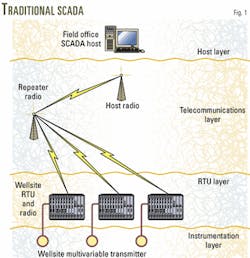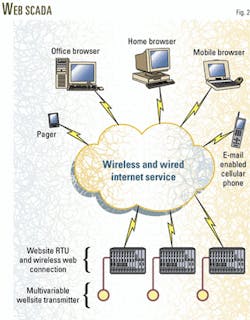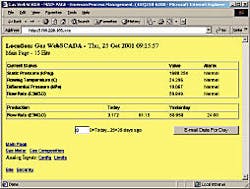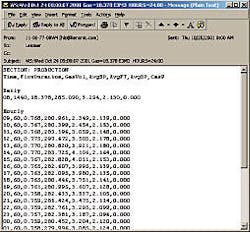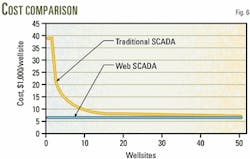Based on a presentation to ISA2001, Houston, Sept. 10-13, 2001.
BP Canada Ltd., a large gas well operator in Can ada, installed a wireless web remotely to monitor and control wellsites in an inaccessible area so that it could produce gas at a maximum rate with a low operating cost.
Wireless internet technologies provide traditional supervisory control and data acquisition (SCADA) features at lower capital and operating costs.
Maximum production
For a gas well, maximum production usually means the elimination of lost production. Lost production or any unplanned gas flow stoppage can be caused by liquid accumulation in the wellbore, freezing of liquids in flowlines, or human error such as leaving a valve closed. To maximize production, one needs to identify and correct these conditions quickly.
Frequent human intervention is the standard approach for keeping a gas well flowing. This means that regularly an operator must travel to the wellsite to check whether the facility is operating correctly.
A daily visit by an operator can be justified if the wellsites are close to each other or easily accessible. But in many cases, that is not the case. Gas wells often are in remote areas with rugged terrain, a hostile climate, thick forests, or sensitive ecosystems. Under these conditions, a daily visit by an operator is impractical.
Traditional SCADA
Producers, such as BP, carefully track operating costs for keeping a gas well flowing at peak production rates. Their objective is to produce the gas safely and efficiently, with the greatest long-term return for their shareholders. The main components of operating expenses are labor, transportation, and measurement.
Most producers use SCADA systems to help them maintain high production rates and reduce operating costs. SCADA allows remote wellsites to be operated from a distant field office without incurring the travel time, transportation expenses, or additional safety risks associated with regular wellsite visits.
It also provides accurate, timely production data that can be integrated into the corporate production accounting system.
The gas production industry has used traditional SCADA systems for more than 2 decades. A typical installation includes a technology stack made up of four layers (Fig. 1). As have most large producers, BP has installed the traditional SCADA architecture in many places and is well aware of the costs and complexities involved in building and maintaining a system to monitor wellsites remotely.
The problem with a traditional SCADA system is that it is often expensive, causing producers, such as BP, to look continually for better long-term solutions based on up-front capital costs, ongoing operating costs, system reliability, outsourcing, security, and overall system performance.
Traditional SCADA has the high cost associated with configuring, testing, documenting, commissioning, and maintaining a host computer system. Also, producers must grapple with the situation that a company specializing in gas production may not be the most efficient for building and operating its own telecommunications infrastructure.
The traditional SCADA system, therefore, does not always fit everyone. In particular, its weaknesses include:
- High infrastructure costs. Before even a single wellsite can be automated, an infrastructure consisting of a host computer and telecommunications network must be constructed.
- Telecom expertise requirements. Maintaining a radio network requires some specialized training, tools, and experience. With small staff sizes, this expertise is often purchased on an hourly basis from a local contractor.
- Host expertise requirements. Although most SCADA host software is now sold as a "shrink-wrapped" personal computer (PC) application, it is still very complex and requires an experienced user to configure.
- Revisions required for expansion. As new wells are added to the traditional SCADA system, more work is required on the SCADA host for revisions to graphic displays, new tag definitions, and data reporting.
- Data integration customization. Moving the data from the SCADA system to the production accounting system often requires considerable customization.
- Data sharing difficulties. Often a SCADA system needs to provide the wellsite data to third parties in real time. Providing this interface can be complicated and costly.
Eliminating the host
BP decided that it needed a new approach instead of the traditional host-based SCADA system. It implemented a new architecture that does not use a host. Instead, the system has a wireless internet connection and a remote terminal unit (RTU) and can use any web browser.
This new SCADA system without a host is fundamentally different from a traditional one (Fig. 2). At the instrument level, this system has the same three-in-one multivariable flow transmitter that is often used for traditional host-based SCADA systems. It communicates with the local RTU with the Modbus protocol at 9,600 baud. Parameters transferred include static pressure, differential pressure, and temperature.
But fundamental changes are apparent at the RTU level, although some functions are the same.
The RTU, as with many gas wellsite RTUs, receives process information from the transmitter and performs gas flow calculations (American Gas Association Report Nos. 3 and 8). It also stores hourly production data for 35 days in accordance with American Petroleum Institute (API Chapter 21) guidelines, controls other input-output (I/O) points, and performs ladder logic.
At this point, similarities with traditional RTUs end. Instead of acting as a slave to a SCADA host master computer, each RTU assumes the role of a server on the worldwide web. The function it performs is a combination of old SCADA-based features and new e-business technologies.
Web-enabled capabilities
As a web server, each RTU has a unique universal resource locator (URL), or web address. That is, one can access each RTU from any web-connected browser, such as Microsoft Internet Explorer or Netscape Navigator. A typical web SCADA RTU address is http://198.228.170.157/; Fig. 3 is a screen capture of parameters and alarms.
Until recently, the prospect of turning a simple RTU into a web server would have seemed ridiculous. Web servers are thought of as extremely powerful computers with terabits of hard-disk space and gigabits of memory, which is true for large web sites with thousands of concurrent users.
For a small wellsite with one user, however, a fit-for-purpose web-based SCADA requires only a low bandwidth, miniscule memory, and limited processing ability. The ever-present wireless internet is the key technology that made this possible.
Throughout North America, the wireless internet exists in almost all gas producing areas, although the underlying technology differs slightly depending on the jurisdiction.
The wireless web is usually a digital component of the cellular telephone spectrum with the internet service provider (ISP) typically being the cellular phone company. The coverage generally overlaps the same territory where voice coverage exists.
For BP, this was a key to the project's success. Its wellsites, although in difficult-to-reach terrain, all had good wireless web coverage. BP's local ISP-cellular phone service provider, Telus Mobility, Calgary, a business unit of Telus Corp., uses cellular digital packet data technology to deliver the wireless internet service.
The implemented web-based solution provides many of the same features as a traditional SCADA system including real-time view of data, alarm notification, data logging, and remote configuration
Access from anywhere
The wellsite RTU can be accessed from anywhere because it is a server on the worldwide web. With a browser, the wellsite URL, and a password, one can view wellsite data in real time.
This is a significant advantage for those situations in which the data are needed by more than just the operator. With this accessibility, other parties such as the engineering department and third-party interest owners also can view the data in real time.
For the operator, a web-based wellsite creates a huge spin-off benefit. Now a wellsite can be viewed and controlled from the field office, a home office, or even a truck office. Handheld PCs, palm-size organizers, or laptop computers all can connect to the wireless web connection, allowing the operator more mobility and more productivity.
Alarm notification
E-mail is one way operators can be alerted to a problem such as no-flow. When the flow rate drops below the preconfigured low-flow threshold, the RTU will generate an alarm e-mail that informs the operator of the abnormal condition. Once in an e-mail format, the alarm can be automatically routed or forwarded to any address.
BP's operators all carry alphanumeric pagers, or cell phones that support text messaging. Its system, therefore, sends alarm e-mails automatically to a server in its field office. From there, the system reconfigures the e-mail in Microsoft Outlook software and forwards it to the pager-cell phone ID numbers.
The alarms can be routed to different operators depending on the well location because each alarm contains a unique wellsite name in the header. The simplicity of this arrangement cannot be overlooked. Because e-mails are forwarded using Microsoft Outlook, operators can reconfigure and manage the system themselves to handle vacations or sick days.
Site configuration
As with all flow computers, one must configure the web-based RTU before it can correctly calculate gas flow rate. Parameters that must be set first include the meter run dimensions and gas composition. Unlike most flow computers, however, these parameters can be configured over the internet.
A company measurement technician or operator can enter these password-protected values from a web browser in the office and eliminate going to the wellsite if these values change as a result of a resized orifice plate or changed gas composition.
As specified in API Chapter 21 guidelines, the RTU stores changes to the flow calculation parameters for 35 days. The system also logs these changes as part of the daily e-mail statement.
Production data
The web-based RTU creates an e-mail message for delivering daily production data. Contained within this message is the following information:
- Wellsite ID.
- Snapshot information that includes the current wellsite parameters, such as meter run values and outstanding alarms.
- Event logging messages, such as changes to meter run or gas composition parameters.
- Production data, such as 24-hr records indicating time of day, raw average meter-run readings, and hourly production total.
This e-mail is generated at a user-defined time. BP selected 8:00 am to correspond with the contract hour.
Fig. 4 shows the information in the daily production e-mail in a comma-separated variable format. An operator can read this format directly or import it into a spreadsheet, such as Microsoft Excel, for analysis.
Data management may become a problem for operators with more than one or two wellsites equipped with a web-based RTU. One way to handle these data is by creating a small Visual Basic application that works with Microsoft Outlook to manage the incoming daily e-mails and store the data in a more usable format.
The Visual Basic application then continually scans the inbox looking for messages generated from one of the wellsite RTUs.
Upon receipt of an alarm message or a daily production record, the application first parses the data from incoming e-mails and inserts the information into a structured query language (SQL) compatible relational database. It then automatically removes the e-mail from the inbox.
As new sites are brought online, one does not need additional configuration of this database. The system automatically adds new sites to the table upon first receipt of an e-mail. This is a tremendous engineering time saver over traditional SCADA system configuration practice.
The Visual Basic application provides all of the data management tools one would expect from a relational database. In particular, the application supports filtering, graphing, and reporting.
In filtering, a user selects individual wellsites or groups of wellsites or producing fields and a date range of data to view. A user can graph any of the process variables including flow volume, pressure, or temperature and produce reports for any well or group of wells for any date range.
Fig. 5 shows a screen capture of a data management tool.
The Visual Basic application can reside on any number of client machines such as a PC at the field or head office. For multiple site viewing of the data, one approach is to forward the daily production e-mails to all locations.
Another approach, used by BP, is to view the production data with an ActiveX component. This approach allows any BP employee to view wellsite data from any web browser on the company intranet.
Advantage
BP's new web-based SCADA system provided several advantages over a traditional host-based SCADA system, such as:
- No infrastructure costs. The web-based SCADA system does not need a dedicated host computer or dedicated telecommunications network. The result is that SCADA is now economical for even a single wellsite. Effectively, the cost-per-wellsite remains constant regardless of how many wellsites are automated (Fig. 6).
- No telecom expertise required. The web-based SCADA system effectively out-sources the telecommunications service to the local wireless ISP. It is, therefore, the ISP's responsibility to provide any backup generators, uninterruptible power supply (UPS), and 24-hr, 7-day support necessary to keep the system operational.
- No host expertise required. It requires no technical expertise because the web-based SCADA system does not have a host computer. This results in significant savings over a traditional SCADA system that would periodically require consultants to fly in and maintain and upgrade the system. The RTU software now handles all host functions.
The operator's view into the RTU and its meter-run configuration parameters is done over the Internet. There is no dedicated graphical user interface (GUI) software to own and maintain. The system only needs an internet browser.
- Painless expansion. As BP automates new wellsites with web-based RTUs, the overall system expands effortlessly. There are no graphics, databases, or reports that need to be adjusted to accommodate the new sites. The production reporting system application adds a new wellsite to the table automatically upon first receipt of its production e-mail.
- Data integration. A user can access the daily production from the wellsite in either a comma separated or an SQL-compatible database format. The data then can be exported to or shared with the production accounting systems.
- Data sharing. All stakeholders with web access and password privileges can view and retrieve well data in real-time and receive daily notifications of the hourly production record.
The author
Robert Cottingham is an automation engineering consultant with Kenonic Controls, Calgary, a division of Emerson Process Management. He has 14 years of industry experience in the design, implementation, and management of SCADA, PLC, and DCS systems. Cottingham holds a BS in electrical engineering.

